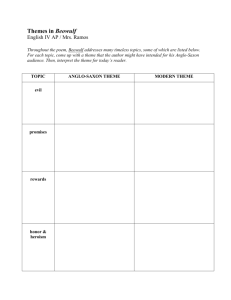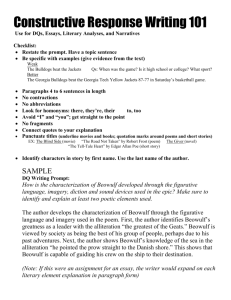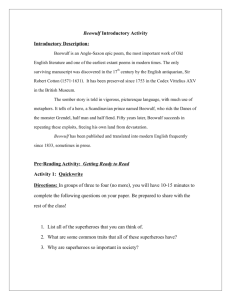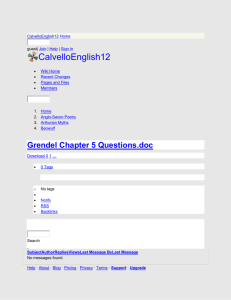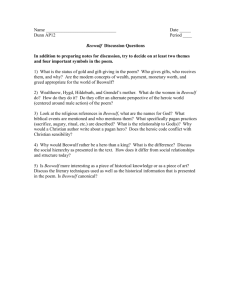Beowulf - CHS AP English
advertisement
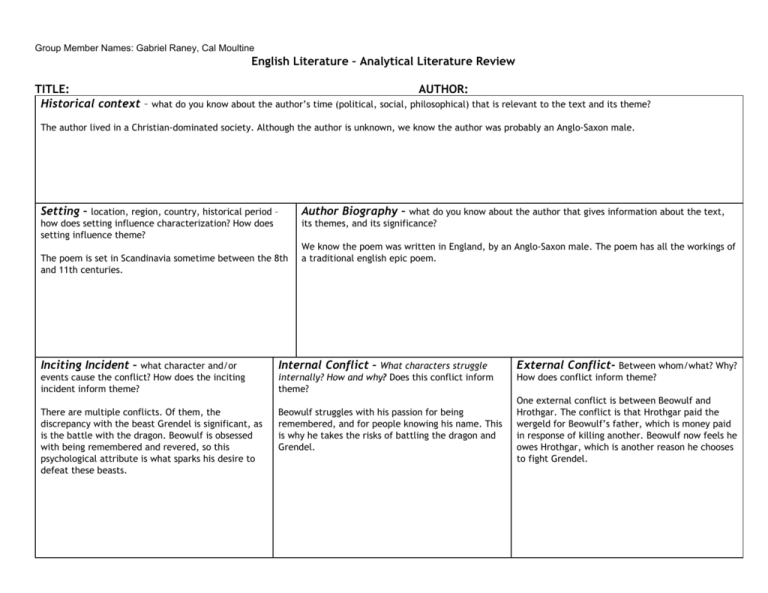
Group Member Names: Gabriel Raney, Cal Moultine English Literature – Analytical Literature Review TITLE: AUTHOR: Historical context – what do you know about the author’s time (political, social, philosophical) that is relevant to the text and its theme? The author lived in a Christian-dominated society. Although the author is unknown, we know the author was probably an Anglo-Saxon male. Setting – location, region, country, historical period – Author Biography – what do you know about the author that gives information about the text, how does setting influence characterization? How does setting influence theme? its themes, and its significance? The poem is set in Scandinavia sometime between the 8th and 11th centuries. We know the poem was written in England, by an Anglo-Saxon male. The poem has all the workings of a traditional english epic poem. Inciting Incident – what character and/or Internal Conflict – What characters struggle External Conflict- Between whom/what? Why? events cause the conflict? How does the inciting incident inform theme? internally? How and why ? Does this conflict inform theme? How does conflict inform theme? There are multiple conflicts. Of them, the discrepancy with the beast Grendel is significant, as is the battle with the dragon. Beowulf is obsessed with being remembered and revered, so this psychological attribute is what sparks his desire to defeat these beasts. Beowulf struggles with his passion for being remembered, and for people knowing his name. This is why he takes the risks of battling the dragon and Grendel. One external conflict is between Beowulf and Hrothgar. The conflict is that Hrothgar paid the wergeld for Beowulf’s father, which is money paid in response of killing another. Beowulf now feels he owes Hrothgar, which is another reason he chooses to fight Grendel. Symbolism - abstract or concrete? What are they? How does symbolism inform Tone – How is the author’s and/or speaker’s attitude evident in the theme? text? When Beowulf cuts off Grendel’s head, the head symbolizes Beowulf’s pride in himself. Characterization – Name & Analysis of major characters. how and what type – flat/round? Static/dynamic? Stock? Protagonist/Antagonist/Foil? Motivation? Attitudes? How does characterization inform theme? Beowulf: Prideful; Protagonist; Motivated by desire to be remembered; Flat character. The translator has a more conspicuous effect than the author in this story. The translator, being a monk, adds a Christian spin to the epic poem. Figurative language and literary devices – what devices are most prominent? What do they mean? How does the meaning relate to the theme? Symbolism is used. The amount of water prevalent in Beowulf represents the danger of crossing it, and taking a risk like that. Universal application – What specific themes are relevant to life/the human condition beyond the pages of the text? Answer “so what?” for the themes—why does this text matter? A theme in Beowulf that is relevant to the human condition is the idea of being remembered. Although the book was written over ten centuries ago, Beowulf is considered an incredibly important piece of literature in society.


